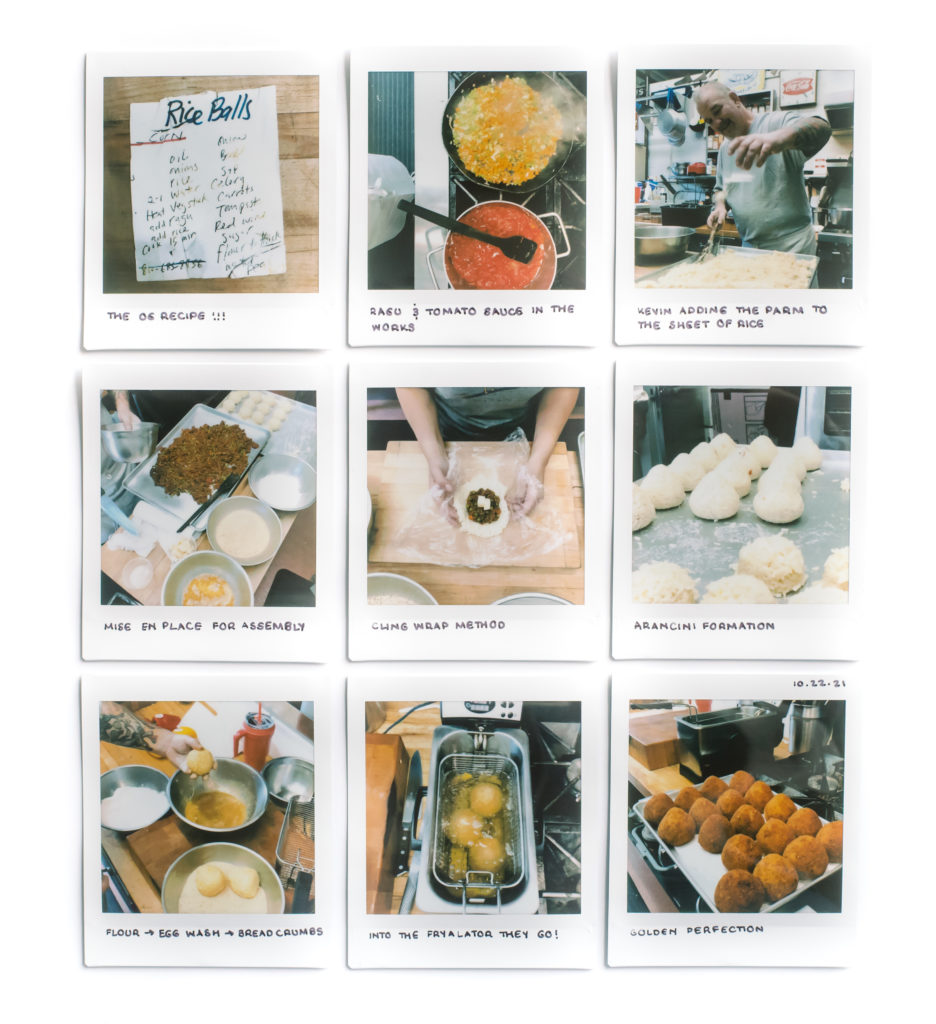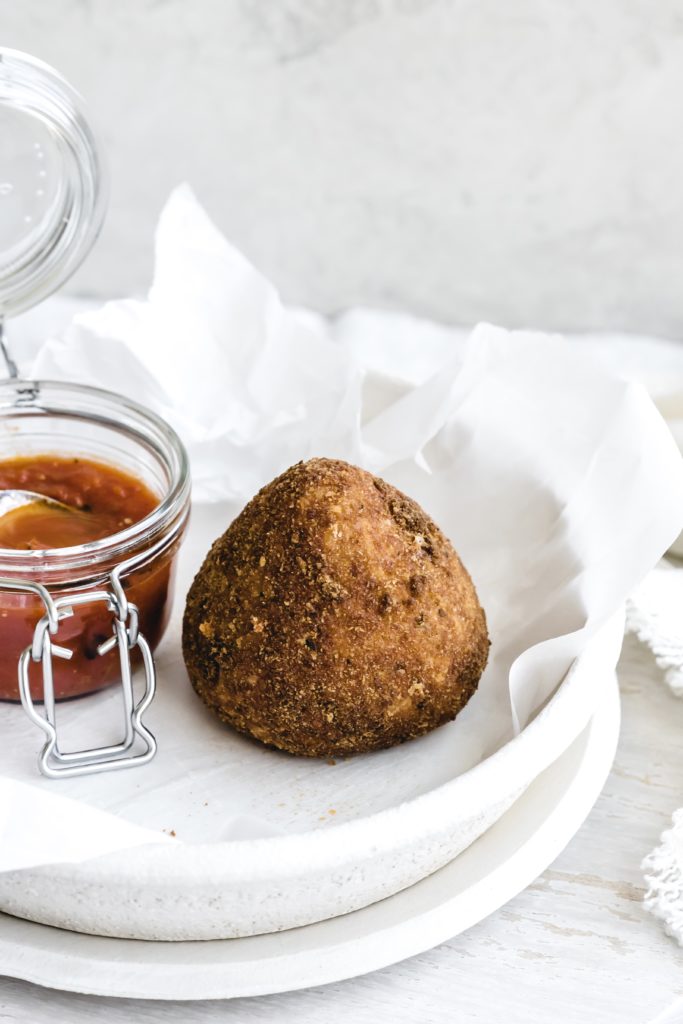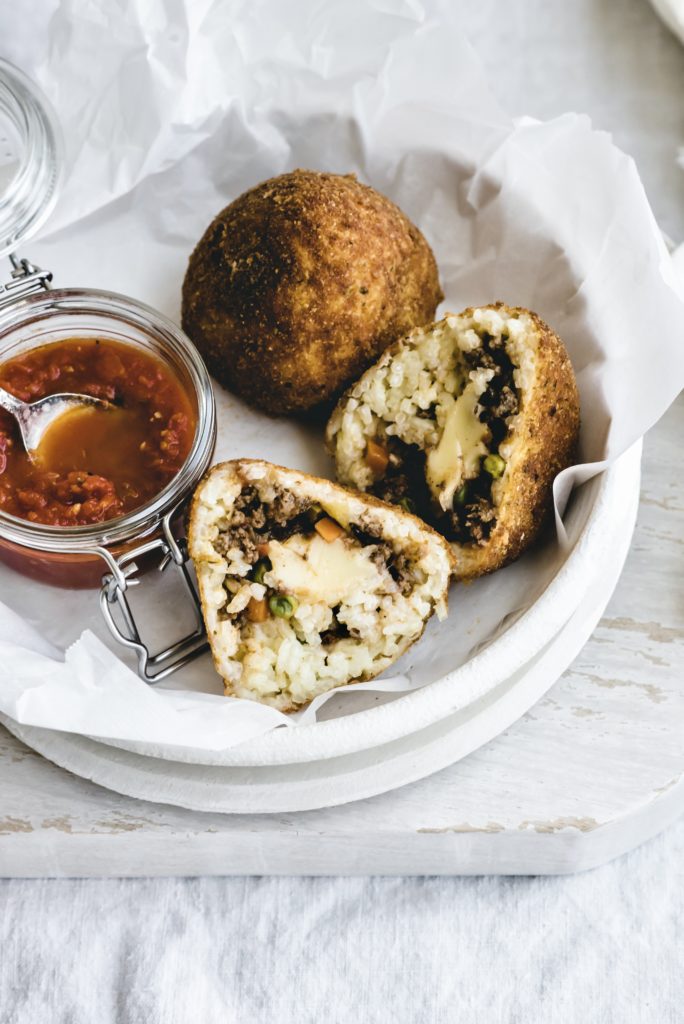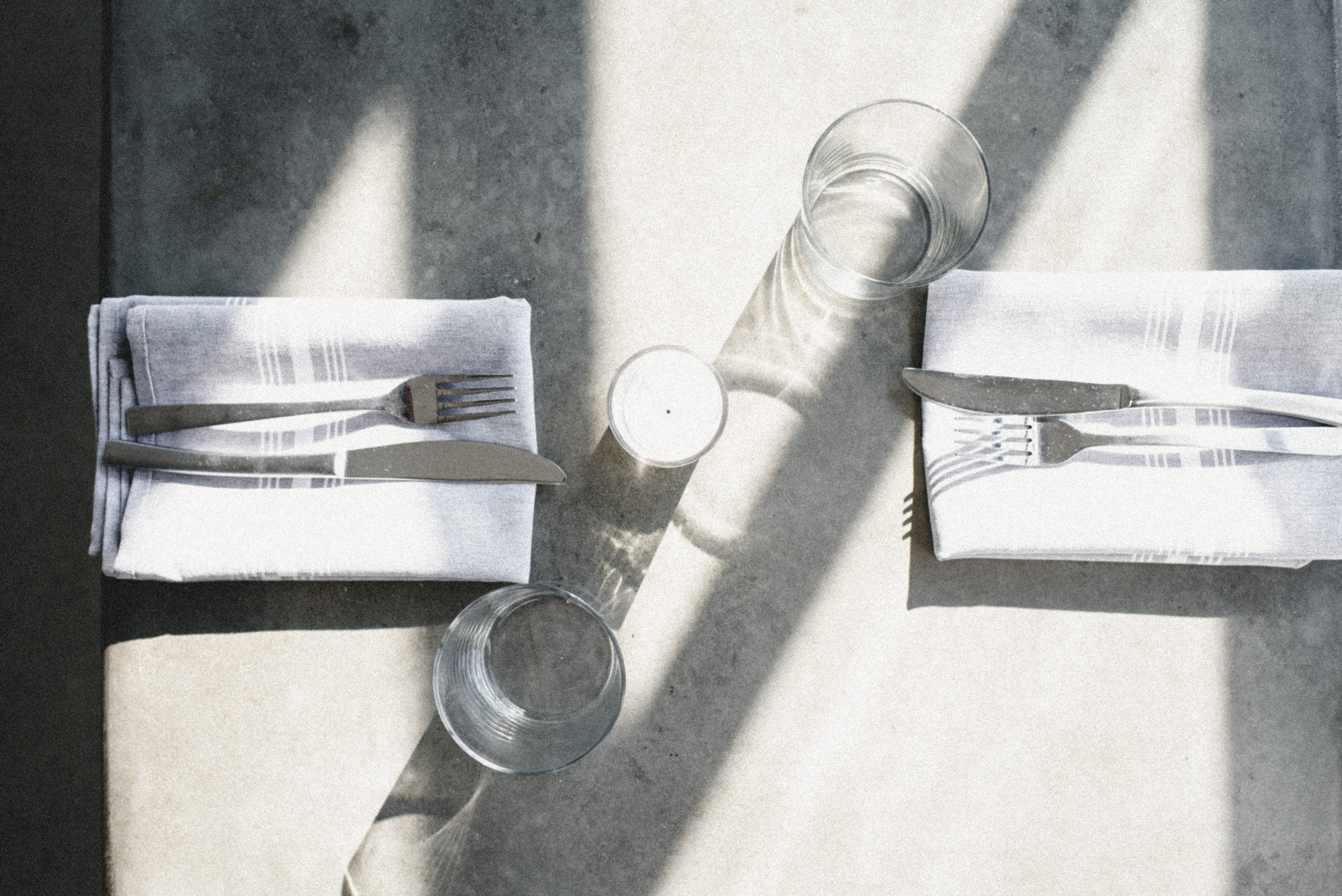Have you ever had Sicilian rice balls AKA arancini? It’s unreal! The other day I taught Kevin Kendall from Olive Oyl’s how to make Korean-fish Fried Chicken. In return, he shared his method for how to make his Sicilian Arancini, inspired by his and his wife’s travels! Though Kevin only had a small list of ingredients as a recipe, making and tasting, and developing these written instructions was nothing short of entertaining and delicious!
Anyways, I digress. This version of arancini is a golden and crispy ball of breaded rice, consisting of ragu, stringy mozzarella, and aromatic rice… And oh, is it sooo good! All the time and effort it takes to make this dish is well worth the patience!
That said, since it is certainly a labor of love to make these, I hope the snapshots Kevin let me take can help guide in a way that words cannot. Though, I cracked up because one of the employees who made them with Kevin for the past 20+ years, joked that it is more like a pain in the a$$ hahah! Nevertheless, I think you should try making these at least once in your lifetime!
P.S. Although these images do not show the awesome, stringy cheesiness from the mozzarella, so just imagine an even more deliciously fun experience when you make these yourself!
Fun Facts about Arancini:
- The most widespread origin theory of arancini stems from an analysis of the ingredients. The ingredients trace back to the High Middle Ages, which was during the Arab occupation from the 9th to 11th century AD. This moment in time influenced history and culture, as well as the food of Trinacria, which is present-day Sicily.
- Rumor has it that Arabs were responsible for introducing spiced rice, flavored with saffron. They served the rice on a large plate, surrounded with additional plates with meat and vegetables. People served themselves by taking some rice into their hand and pairing it with the accompanying food.
- In the 12th century, they rounded the handful of rice and fixings, then breaded and fried the “rice balls”. Since this process helped hold it all together they became great for traveling because they are also filling.
- During the 17th century in Palermo, Trapani, and Sicily, arancini became a traditional food for the feast of Santa Lucia. The feast of Santa Lucia’s Day commemorates the arrival of a grain supply ship back in 1646, which at the time, relieved a severe famine. Nowadays, leading up to the holiday on December 13th, Italians do not eat bread and pasta to honor the history of that moment.
- Arancini has many variants such as: a perfectly round version filled with a ragu mixture of meat, mozzarella and peas. Another is called al burro (“with butter”), which has a longer, pear-like or oval shape, and consists of fresh mozzarella and prosciutto, along with grated cheese or béchamel. There are also versions with fried eggplant, tomato sauce, and salted ricotta, and others with Sicilian salmon. There is also a sweet version stuffed with gianduia cream or chocolate, and sprinkled with icing sugar. Some gourmet variants include pistachios with scamorza or sardines with wild fennel. All in all, there are about 30 varieties.




Kevin’s Sicilian Arancini
SERVES: 20-24
PREP TIME: 30 MINUTES
COOK TIME: 60 MINUTES
TOTAL TIME: 90+ MINUTES
Simple Tomato Sauce:
- 1 small onion, finely diced
- 1 Tbs olive oil
- 2-3 cloves garlic, minced (about 2 Tbs)
- 3 lb. crushed tomato
- salt and pepper to taste
- (optional) herbs like oregano, marjoram, basil, parsley
- In a large skillet over medium heat, warm the oil. Add the onions and cook until translucent, about 8-10 minutes.
- After, add the garlic and cook until fragrant, about 1 minute.
- Stir in the crushed tomatoes and season with salt and pepper. (Now is a good time to add fresh herbs if desired.)
- Bring sauce to a boil then reduce to a low simmer. Cook until the sauce reduces and flavors meld together, about 20-40 minutes. Adjust the heat as needed to maintain a steady simmer. When ready, remove sauce from heat, cover, and set aside.
Ragu Method:
- 1 lb. ground beef (or Impossible grounds for vegetarians!)
- 1 Tbs olive oil
- 2 carrots, finely diced (about 1/2 cup)
- 1 small onion, finely diced (about 1/2 cup)
- 2 ribs celery, finely diced (about 1/2 cup)
- 2-3 cloves garlic, minced (about 2 Tbs)
- 3/4 cup tomato sauce
- 1 cup peas
- 2 Tbs all purpose flour
- 2 Tbs granulated sugar
- 1/2 cup red wine
- Bring a large skillet to medium heat and add olive oil. Afterwards, add the ground beef and stir occasionally. Cook until browned, or about 5-8 minutes. Afterwards, drain the beef and set aside.
- Next, use the same skillet and bring olive oil to medium heat. Add the onions, carrots, and celery then sauté. Stir occasionally until the ingredients sweet and onions turn translucent, about 8-10 minutes. Add the garlic and cook for another minute, or until fragrant.
- Afterwards, return the beef grounds and into the pan. Stir in the flour and sugar, then add the wine and cook until the alcohol reduces, about 1 minute. Then, add the tomato sauce and reduce the heat to medium-low. Simmer, stirring occasionally, for about 10 minutes.
- Then, add the peas and continue to simmer the sauce for another 8-10 minutes, or until the peas are vibrant green and tender. The sauce should thicken into a beautiful ragu. Season to taste.
- Afterwards, transfer and spread the meat sauce onto a baking sheet and set aside to cool off.
Cheesy Rice:
- 1/2 small onion, finely diced
- 1 Tbs olive oil
- 2 cups Arborio rice
- 4 cups vegetable stock (seasoned to taste)
- 1 cup Parmigano-Regianno, grated
- 1 Tbs butter
- salt and pepper
- Bring a medium saucepan to medium heat then add the oil and diced onions. Cook the onions until they begin to sweat, about 5 minutes, then add the rice. Cook to toast for a minute before adding in the stock.
- Increase the heat to high and allow the stock to boil, before reducing to a low simmer. Cover and cook for 15 minutes or until al dente, then stir in the cheese and butter. Season to taste.
- Afterwards, transfer and spread the rice onto a cold baking sheet and set aside to cool off.
Method for assembling Sicilian Arancini:
- 1 lb. low moisture mozzarella, cubed into 1” pieces
- 3 eggs, scrambled, seasoned with salt and paper
- 2 cups flour
- 4 cups Italian bread crumbs
- Return the chilled ragu and rice, then prepare a bowl of water to dip and rinse your hands in. (This makes it easier to shape the rice and prevent everything from sticking to your hands.)
- Wet your hands and scoop a 1/2 cup portion of rice into your non-dominant hand. Use your other hand to poke and create a well in the middle of the rice. Add, about 2 Tbs ragu into the rice and center a cube or two of cheese. Carefully use your hands to enclose the ingredients with the rice. Pat and shape the mound into a pear figure. Set aside on a platter and repeat the process with remaining ingredients.
- Afterwards, prepare 3 mixing bowls: one with flour, one with eggs, and the last with breadcrumbs. Take a rice ball and coat in the flour. Tap off any excess then transfer to coat in the egg mixture. Lastly, shake off excess egg wash and roll the arancini into the bread crumbs.
- Reshape as needed and repeat with remaining pieces. Set aside until ready to fry.
Method for frying Sicilian Arancini:
- First, line a baking sheet with paper towels and/or a wire drying rack. Then, using a deep-fryer or deep frying pan, add enough oil to completely cover the size of the arancini, and bring the frying oil up to 350°F.
- Next, submerge a few pieces into the frying oil. Fry for about 5-7 minutes or until golden brown and crispy. (Timing may vary depending on the size of your machine or pan.)
- Afterwards, set aside to drain on the baking sheet until ready to eat. When ready, pair the arancini alongside the tomato sauce and enjoy!
Notes:
- You can make components of this Sicilian Arancini recipe ahead of time. For example, you can prepare the ragu and the sauce hours in advance or even a day or two. It is easiest to assemble with chilled ingredients. Also, allowing the ragu and the sauce to marinate also helps develop and merge the flavors.
- The simple sauce can take as little as 20 minutes or as long as a few hours. Kevin prefers to let it simmer for the duration of preparing everything else. Another option is to buy sauce already made.
- For the rice, think of the ratio as 2 parts water to 1 part rice. You can use any stock and also add white wine for extra depth of flavor.
- You can add saffron to the rice mixture by blooming a pinch (or about 1/4 tsp) of saffron in the stock for a couple minutes before cooking with.
- For a vegetarian version, swap the beef for impossible grounds or plant-based “meat” of choice.
- To assemble the arancini you can use cling wrap to help shape them. Though it is not traditional, it is a quicker and easier method. Again, I state: this is not traditional!
- Arancini can keep in the fridge for up to 5 days in an airtight container. They are great reheated in the oven at 400°F for 10-15 minutes.
- There are a handful of awesome references on how to make various types of arancini. Here are some picture heavy resources that help to explain: Recipes From Italy, Spruce Eats, and Nonna Box.
- To learn more about the history of arancini visit resources like: Grande Voyage Italy, World Foods & Recipes, Mama Napoli Foods.




